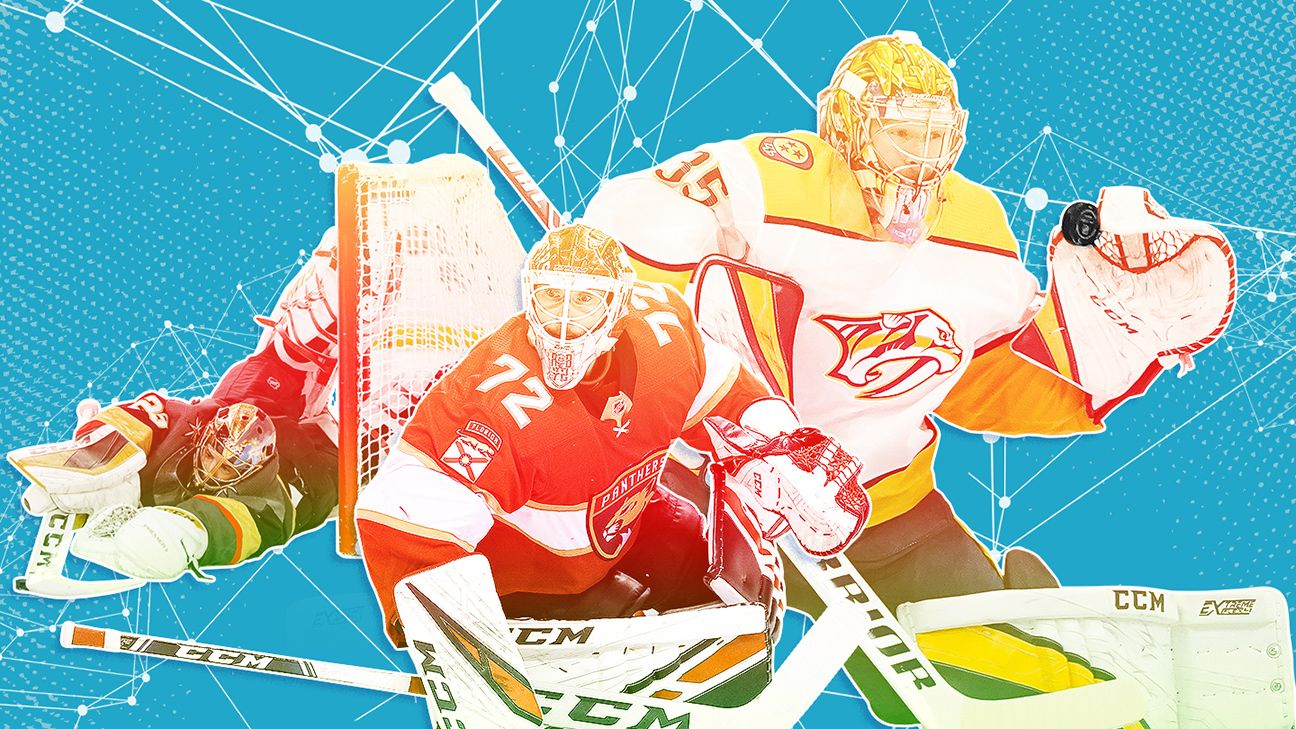Today’s NHL is loaded with skill and talent up and down the ice. But what would the perfect player look like? Using the attributes of current NHL stars, we set out to create the perfect forward, defenseman and goaltender.
We complete the series here by building the ultimate goaltender from 15 skills and characteristics of players around the league.
Jump to:
Fundamentals | Awareness
Style | Save type
See more: Forward | Defenseman


Goalie guru Kevin Woodley once called Price “a living how-to-be-a-goalie” instructional video. His patience might be his best virtue, and that’s born out of the soundness of his technique. When he’s on, Price’s fluid movements and low-to-the-ice style allow him to track pucks through traffic. He is one of the best in hockey at letting the play come to him.

Hart is a fundamentally sound goalie whose positioning defies the 21-year-old’s inexperience. As the Flyers add more to his repertoire, it’s that patient positioning that Hart relies on to excel.

If Hellebuyck, the probable Vezina Trophy winner in 2019-20, has one elite goaltending virtue, it’s his patience on shot attempts from straight ahead of him. Many goalies believe that shooters can’t beat them unless they allow them to; Hellebuyck embodies that. He posted a sparkling .922 save percentage in 56 starts — 79% of the Jets’ games — this season.

With Anderson now 39 years old, this pick might seem like some “with experience comes wisdom” rationalization. But Anderson’s ability to read the game has allowed him to punch above his weight during a 17-year NHL career. Vegas’ Robin Lehner recently credited Anderson as an inspiration for his turnaround as a goalie, via the Ottawa Sun: “He’s very smart. It’s not pure butterfly. It’s a hybrid. He stands up [on] some saves. It’s about reading plays. And I just learned so much from him.”

If “Play Gloria” was the defining battle cry for the 2019 Stanley Cup champion St. Louis Blues, “Do I look nervous?” was a close second. That line was uttered by Binnington after he was asked if, as a rookie, he was nervous playing in close games. That swagger led him all the way to a Game 7 victory in the Stanley Cup Final, and it’s part of the reason he has been able to post an .865 high-danger save percentage this season, tops among goalies with at least 50 games played, according to Natural Stat Trick.

Flexibility and athleticism earned last season’s Vezina winner the ultimate comparison for a goaltender: Dominik Hasek, another netminder who moved incredibly well and took away whatever advantage a shooter thought he had. According to Natural Stat Trick, Vasilevskiy’s 37.72 goals-saved above average the past three seasons ranks No. 1 in the NHL.

The NHL sample is small, but skating ability is one reason Shesterkin quickly became a rookie sensation. The speed with which he gets to his edges from a slide is incredible to watch, as he covers a wide swath of ice in a blink.

There are different kinds of aggressiveness with goaltenders. There’s the bad kind, when they flop out of position. There’s the risky kind, when they skate out and thrust their sticks on poke checks. Then there’s the Ben Bishop kind, when the 6-foot-7 goalie swings his stick from side to side on the ice like a battle axe on plays around his net.

The Panthers’ netminder has one of the prettiest butterflies in the NHL, and he can be an unbeatable goalie down low when he drops into it because of his core strength and movement. His issue — and that of many butterfly-style goalies — is dropping too soon. With two Vezina awards to his credit, however, Bobrovsky is doing something right.

InGoal Magazine once called Rinne’s glove “the place where rebounds go to die.” Rinne’s ability with his glove has sometimes been likened to that of a Major League Baseball shortstop, and there’s a reason for that: Rinne grew up in Finland playing Pesäpallo, a distant cousin to American baseball.

The Stars’ No. 2 goalie has made a habit of making spectacular, lunging blocker saves that end up on highlight reels. That strength helped Khudobin to a league-leading .945 even-strength save percentage this season.

Among goalies with at least 18 games played in the shootout in their careers, no one has a higher save percentage (.852) than Vasilevskiy, who has allowed just nine goals on 61 shots. This is one area in which you can really see that aforementioned athleticism.

Fleury is the best goalie in the NHL when it comes to reacting inside of chaotic situations. His speed, reflexes and, above all, aggressiveness allow him to thrive in those moments when the net is wide-open and he needs to find a way to keep the puck out. You might recall this gem from earlier this season …
Save of the Year by Marc-Andre Fleury or… ? pic.twitter.com/QX5YM0oL7l
— NHL (@NHL) November 20, 2019

Rask was not always an elite-level rebound-control goalie in his early years. It’s an area of his game that has really improved. Of course, for anything he doesn’t grab, a few all-world defenders on the Bruins are there in front of him to clean it up. That rebound-control ability has helped him to a save percentage north of .900 in 73.2% of his starts this season, fourth in the NHL.

Although not on the level of a Martin Brodeur or Marty Turco, Smith’s puck-handling skills make him an effective third defenseman and have shown to have a positive impact on his team’s shot generation. Since entering the league in 2006, Smith has 17 assists and one goal, back in 2013.
